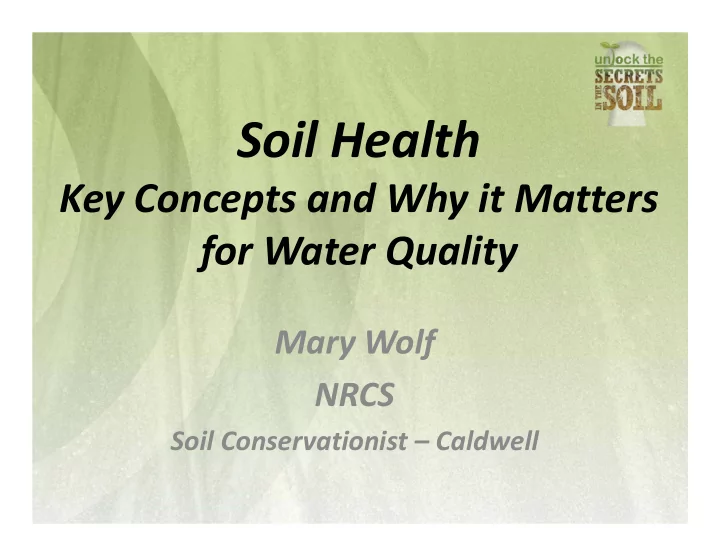

Soil Health Key Concepts and Why it Matters for Water Quality Mary Wolf NRCS Soil Conservationist – Caldwell
What is Soil Health? • The continued capacity of the soil to function as a complex, living ecosystem – Habitat sustaining soil organisms, plants, animals, people – Physical Stability (resistance to erosion) – Nutrient and energy cycling – Water (infiltration & availability)
Healthy Soils: • Have a high content of Organic Matter (OM) • Sequester carbon • Are high performing (cycle nutrients, healthy crops) • Can biodegrade pesticides (microbes break down) • Are more resistant to erosion, reducing sediment runoff and nutrient loading • Hold more water and have less runoff -- 1% increase can hold 27,000 gallons per acre -- increase from 1 - 4.5% doubles AWC • Protect natural resources on- and off-farm
What is Soil Organic Matter? • Biologically • OM holds the soil produced together (aggregates). molecules (e.g. • OM is THE source of carbohydrates, soil fertility in the proteins, glomalin) system. • Biological debris • Lose it, and you must (dead organisms) use synthetic inputs to • Breakdown grow crops, especially products of both of N, S, and P the above
Soil Aggregates soilquality.org
Managing for Soil Health • Diversify as much as possible • Keep plants (living roots) growing in the soil throughout the year • Keep the soil covered at all times with plants and plant residues • Disturb the soil as little as possible • MIMIC NATURE ‐‐ create the most favorable habitat possible for soil organisms
How do these Ecosystem flourish without human inputs? Forest Prairie
Managing for Soil Health • MAXIMIZE inputs = more PLANTS, animals if possible • MINIMIZE losses = reduce TILLAGE
INPUTS: Plants • Roots deliver carbohydrate and nutrients to the rhizosphere, fueling the entire soil ecosystem and building Organic Matter. • Biodiversity is the key. • Introducing diversity aboveground promotes diversity below ground. • Use crop rotation and multi ‐ species cover crop mixes, herbivores if possible
The Rhizosphere • Zone in the soil < 5mm from the plant roots • 20 ‐ 50% of a plant’s photosynthate ends up released through roots • Higher population of microorganisms (>10X) than in bulk soil • Nutrient cycling (immobilization; mineralization by decomposers) • Symbiosis (mycorrhizal fungi, rhizobia) • We want to keep the action going year round!
Mycorrhizal fungi • Mutualistic symbiosis between plant and fungus (80% of plants have mycorrhizae) • Plant provides food for fungus ‐ up to 20% of plant’s carbohydrate • Fungus extends root system, providing water and nutrients to plant • Nutrient transfer BETWEEN plants • Hyphae produce glomalin, aggregate “glue”
Mycorrhizae on Roots www.pbs.org jgi.doe.gov jgi.doe.gov
Cover Crops: What they do • Roots deliver carbohydrate and nutrients to the rhizosphere year ‐ round • Protect soil surface from the action of water and wind • Suppress weed growth through competition Diverse cover crop mixes
Crop Rotation: What it does • Diversify plant inputs • Break weed, disease, and pest cycles, as each crop has specific problems associated with it. • Each crop has a different physiology ‐‐ therefore roots put slightly different compounds into the soil, encouraging different microbial communities and symbioses.
INPUTS: Grazing Animals • Herbivores eat and trample plants • Plant stress increases in root exudates • Manure/urine deposition provides nutrients = INCREASE in biological activity
Nutrient Cycling • Healthy soil’s OM will cycle and release nutrients for plants during growing season • Less inputs = less loss to surface and ground water North Dakota soil test guide—5 yr No ‐ Till gets 50# N credit. Assumption is that 50# N is released to the crop during season via cycling.
LOSSES: Tillage • Destroys aggregates • Disrupts mycorrhizal fungal networks • Accelerates decomposition of OM • Disrupts soil pore continuity • Reduces habitat and food for soil organisms • Plants weed seeds • Compacts the soil
Tillage Destroys Soil Habitat and Reduces Soil’s Capacity to Function PHYSICAL DISTURBANCE: Tillage induces the native bacteria to consume soil carbon; byproduct is C0 2 . CO 2 CO 2 CO 2
Agricultural soils do not have a water erosion/runoff problem, they have a water infiltration and storage problem.
Management Changes Soil Properties & Capacity of Soil to Function 62.8% loss of SOM after 17 yr intensive tillage 20 cm layer Forest SOM = 4.3 % CT 17 yr ‐ Soybean monoculture SOM = 1.6 %
Minimizing Losses: No Till • Maintains aggregates and pores • Maintains/increases water holding capacity • Limits excess O 2 in the system; maintains/builds OM • Requires banded or seed placed nutrients, rather than broadcast/incorporated
Paradigm Shifts • Paradigm shift #1 Stop treating the symptoms of dysfunctional soil. Solve the problem of dysfunctional soil. • Paradigm shift #2 Conservation practices do not restore soil health. Understanding soil function restores soil health. • Paradigm shift #3 Restoring soil function can be accomplished without going broke. – Apply basic principles of ecology to create quality habitat. – How will this work in the Treasure Valley? – How will producers minimize risk?
Recommend
More recommend